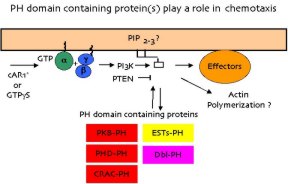- Senoo H, Murata D, Wai M, Arai K, Iwata W, Sesaki H, Iijima M. (2021). KARATE: Protein kinase A-induced KRAS4B-RHOA-mTORC2 supercomplex that phosphorylates AKT in insulin signaling and glucose homeostasis. Mol. Cell. In press.
- Song B, Gu Y, Jiang W, Li Y, Ayre WN, Liu Z, Yin T, Janetopoulos C, Iijima M, Devreotes P, Zhao M. 2021. Electric signals counterbalanced posterior vs. anterior PTEN signaling in directed cell migration of Dictyostelium. Cell Biosci. 2021 Jun 14;11(1):111. PMC8201722.
- Senoo H, Wai M, Matsubayashi HT, Sesaki H, Iijima M. Hetero-oligomerization of Rho and Ras GTPases Connects GPCR Activation to mTORC2-AKT Signaling. Cell Rep. 2020 Nov 24;33(8):108427
- Adachi Y, Kato T, Yamada T, Murata D, Arai K, Stahelin RV, Chan DC, Iijima M, Sesaki H. Drp1 Tubulates the ER in a GTPase-Independent Manner. Mol Cell. 2020 Nov 19;80(4):621-632
- Murata D, Yamada T, Tokuyama T, Arai K, Quirós PM, López-Otín C, Iijima M, Sesaki H. Mitochondrial Safeguard: a stress response that offsets extreme fusion and protects respiratory function via flickering-induced Oma1 activation. EMBO J. 2020 Nov 17;39(24):e105074
- Kato T, Yamada T, Nakamura H, Igarashi A, Anders RA, Sesaki H, Iijima M. The Loss of Nuclear PTEN Increases Tumorigenesis in a Preclinical Mouse Model for Hepatocellular Carcinoma. iScience. 2020 Sep 10;23(10):101548
Murata D, Arai K, Iijima M, Sesaki H. Mitochondrial Division, Fusion and Degradation. J Biochem. 2020;167:233-241
- Itoh K, Murata D, Kato T, Yamada T, Araki Y, Saito A, Adachi Y, Igarashi A, Li S, Pletnikov M, Huganir RL, Watanabe S, Kamiya A, Iijima M, Sesaki H. Brain-specific Drp1 regulates postsynaptic endocytosis and dendrite formation independently of mitochondrial division. Elife. 2019 Oct 11;8. pii: e44739.
Senoo H, Kamimura K, Kimura R, Nakajima A, Sawai S, Sesaki H, Iijima M. Phosphorylated Rho-GDP directly activates mTORC2 Kinase toward AKT through dimerization with Ras-GTP to regulate cell migration. Nature Cell Biology. 2019; Epub ahead of Print
Yamada T, Dawson TM, Yanagawa T, Iijima M, Sesaki H. SQSTM1/p62 promotes mitochondrial ubiquitination independently of PINK1 and PRKN/parkin in mitophagy. Autophagy. 2019; In press.
- Adachi Y, Iijima M, Sesaki H. An unstructured loop that is critical for interactions of the stalk domain of Drp1 with saturated phosphatidic acid. Small GTPases. 2018 Nov 2;9(6):472-479. doi: 10.1080/21541248.2017.1321614. Epub 2017 Jun 23.
Kriebel PW, Majumdar R, Jenkins LM, Senoo H, Wang W, Ammu S, Chen S, Narayan K, Iijima M, Parent CA. Extracellular vesicles direct migration by synthesizing and releasing chemotactic signals. J Cell Biol. 2018;217(8):2891-2910.
- Yamada T, Murata D, Adachi Y, Itoh K, Kameoka S, Igarashi A, Kato T, Araki Y, Huganir RL, Dawson TM, Yanagawa T, Okamoto K, Iijima M and Sesaki H. (2018). Mitochondrial stasis reveals p62-mediated ubiquitination in parkin-independent mitophagy and mitigates nonalcoholic fatty liver disease. Cell Metab. 2018 Oct 2;28(4):588-604.e5.
Itoh K, Adachi Y, Yamada T, Suzuki TL, Otomo T, McBride HM, Yoshimori T, Iijima M, Sesaki H. A brain-enriched Drp1 isoform associates with lysosomes, late endosomes, and the plasma membrane. J Biol Chem. 2018 Jul 27;293(30):11809-11822.
- Igarashi, A., Itoh, K., Yamada, T., Adachi, Y., kato, T., Murata, D., Sesaki, H., and Iijima, M. (2018). Nuclear PTEN deficiency causes microcephaly with decreased neuronal soma size and increased seizure susceptibility. J Biol Chem. 2018 Jun 15;293(24):9292-9300
- Kameoka S, Adachi Y, Okamoto K, Iijima M, Sesaki H. 2017. Phosphatidic Acid and Cardiolipin Coordinate Mitochondrial Dynamics. Trends Cell Biol. [Epub ahead of print].
- Adachi Y, Itoh K, Iijima M, Sesaki H. 2017. Assay to measure interactions between purified Drp1 and synthetic liposomes. Bio-Protocol. Vol 7, Iss 9.
- Yamada T, Adachi Y, Yanagawa T, Iijima M, Sesaki H. 2017. p62/sequestosome-1 knockout delays neurodegeneration induced by Drp1 loss. Neurochem Int. 2017 May 18. pii: S0197-0186(17)30189-4. doi: 10.1016/j.neuint.2017.05.012.
Yang J-M, Schiapparelli P, Nguyen H-N, Igarashi A, Zhang Q, Abbadi S, Amzel LM, Sesaki H, Quinones-Hinojosa A and Iijima M. 2017. Characterization of PTEN mutations in brain cancer reveals that PTEN mono-ubiquitination promotes protein stability and nuclear localization. Oncogene. Jun 29;36(26):3673-3685. doi: 10.1038/onc.2016.493. Epub 2017 Mar 6.
- Yamada T, Adachi Y, Fukaya M, Iijima M, Sesaki H. 2016. Dynamin-Related Protein 1 Deficiency Leads to Receptor-Interacting Protein Kinase 3-Mediated Necroptotic Neurodegeneration. 2016. Am J Pathol. Nov;186(11):2798-2802.
- Adachi Y, Itoh K, Yamada T, Cerveny KL, Suzuki TL, Macdonald P, Frohman MA, Ramachandran R, Iijima M, Sesaki H. Coincident phosphatidic acid interaction restrains Drp1 in mitochondrial division. Mol Cell. 2016;63:1034-43.
Senoo H, Cai H, Wang Y, Sesaki H, Iijima M. The novel racE binding protein GflB sharpens ras activity at the leading edge of migrating cells. Mol Biol Cell. 2016;27(10):1596-605.
Roy M, Itoh K, Iijima M, Sesaki H. Parkin suppresses Drp1-independent mitochondrial division. Biochem Biophys Res Commun. 2016;475(3):283-8.
- Yamada T, Adachi Y, Iijima M, Sesaki H. Making a division apparatus on mitochondria. Trends Biochem Sci. 2016;41:209-210
Senoo H, Sesaki H, Iijima M. A GPCR handles bacterial sensing in chemotaxis and phagocytosis. Dev Cell. 2016;36:354-356.
Nguyen H-N, Yang J-M, Miyamoto T, Itoh K, Rho E, Zhang Q, Inoue T, Devreotes PN, Sesaki H, and Iijima M. 2015. Opening the conformation is a master switch for the dual localization and phosphatase activity of PTEN. Sci Rep Jul 28;5:12600. doi: 10.1038/srep12600. PMCID: PMC4517176.
Yang J-M, Nguyen H-N, Sesaki H, Devreotes PN, Iijima M. 2015. Engineering PTEN function: Membrane association and activity. Methods. 2015 May; 0:119-124. PMCID: PMC4388803
Yang JM, Nguyen HN, Sesaki H, Devreotes PN, and Iijima M. 2014. Engineering PTEN function: Membrane association and activity. Methods Oct 22. pii: S1046-2023(14)00335-1. doi: 10.1016/j.ymeth.2014.10.018. [Epub ahead of print]. PMID: 25448479
Nguyen, H-N., Yang, J.M., Rahdar, M., Keniry, M., Swaney KF, Parsons, R., Park, B.H., Sesaki, H., Devreotes, P.N. and Iijima, M. 2014. A new class of cancer-associated PTEN mutations defined by membrane translocation defects. Oncogene Sept 29;0. Doi: 10.1038/onc.2014.293. [Epub ahead of print]. PMID: 25263454
- Nguyen HN, Yang JM, Afkari Y, Park BH, Sesaki H, Devreotes PN, and Iijima M. 2014. Engineering ePTEN, an enhanced PTEN with increased tumor suppressor activities. Proc Natl Acad Sci U S A. Jul 1;111(26):E2684-93. PMID: 24979808
Zhang, Q., Tamura, Y., Roy, M., Adachi, Y., and Iijima, M., and Sesaki, H. (2014). Biogenesis and roles of phospholipids in mitochondrial fusion, division and mitophagy. Cell Mol. Life Sci. 71: 3767-3778.
- Sesaki, H., Adachi, Y., Kageyama, Y., Itoh, K., and Iijima, M. (2014). In vivo functions of Drp1: Lessons learned from yeast genetics and mouse knockouts. Biochim Biophys Acta. 1842: 1179-1185.
Nguyen, H-N., Afkari, Y., Senoo, H., Sesaki, H., Devreotes, P.N. and Iijima, M. (2013). Mechanism of human PTEN localization revealed by heterologous expression in Dictyostelium. Oncogene, Dec. 2. Doi: 10.1038/onc.2013.507. [Epub ahead of print]. PMID:24292679. PMCID: PMC4041858 [Available on 2015/6/2]
Sesaki, H., Adachi, Y., Kageyama, Y., Itoh, K., and Iijima, M. (2013). In vivo functions of Drp1: Lessons learned from yeast genetics and mouse knockouts. Biochim Biophys Acta. Epub ahead of print.
Wang, Y., Senoo, H., Sesaki, H. and Iijima, M. Rho GTPases orient gradient sensing in chemotaxis. Proc. Natl. Acad. Sci. USA. (2013). 110: E4723-32.
Chen, C-L., Wang, Y., Sesaki, H., and Iijima, M. Myosin I links PIP3 signaling to remodeling of the actin cytoskeleton in chemotaxis. Science Signaling. (2012). 5: ra10
Tang, M., Iijima, M., Kamimura, Y., Chen, L., Long, Y., and Devreotes, P. Disruption of PKB signaling restores polarity to cells lacking tumor suppressor PTEN. Mol. Biol. Cell. (2011). 22: 437-47.
Wang, Y., Steimle, P.A., Ren, Y., Ross, C.A., Robinson, D.N., Egelhoff, T.T., Sesaki, H., and Iijima, M. Dictyostelium huntingtin controls chemotaxis and cytokinesis through the regulation of myosin II phosphorylation. Mol. Biol. Cell. (2011). 22: 2270-2281
Wang, Y., Chen, C-L., and Iijima, M. Signaling mechanisms for chemotaxis. Development Growth and Differentiation (2011). 53: 495-502
Zhang, P., Wang, Y., Sesaki, H. and Iijima, M. Proteomic identification of PtdIns(3,4,5)P3-binding proteins in D. discoideum. Proc. Natl. Acad. Sci. USA. (2010). 107: 11829-11834.
Pramanik, Md K., Iijima, M., Iwadate, Y., and Yumura, S. PTEN is a mechanosensing signal transducer for myosin II localization in Dictyostelium cells. Genes to Cells. (2009). 14: 821-34.
Chen, L., Iijima, M., Tang, M., Landree, M.A. Huang, Y.E., Xiong, Y., Iglesias, P.A., Devreotes, P.N. PLA2 and PI3K/PTEN pathways act in parallel to mediate chemotaxis. Developmental Cell. Developmental Cell. (2007) 12: 603-614.
Yoshino, R., Morio, T., Yamada, Y., Kuwayama, H., Sameshima, M., Tanaka, Y., Sesaki, H., and Iijima, M. Regulation of ammonia homeostasis by the ammonium transporter AmtA in Dictyostelium Eukaryot Cell. (2007) 6: 2419-2428.
Somesh, B.P., Vlahou, G., Iijima, M., Insall, R.H., Devreotes, P.N., Rivero, F. RacG regulates morphology, phagocytosis and chemotaxis. Eukaryot Cell. (2006) 5: 1648-1663.
Janetopoulos, C., Borleis, J., Vazquez, F., Iijima, M., and Devreotes, P.N. Temporal and spatial regulation of phosphoinositide signaling mediates cytokinesis. Developmental Cell. (2005) 8: 467-477.
Iijima, M., Huang, Y.E., Luo, H.R., Vazquez, F., Devreotes, P.N. Novel mechanism of PTEN regulation by its phosphatidylinositol 4,5-bisphosphate binding motif is critical for chemotaxis. J. Biol. Chem. (2004) 16: 16606-16613.
Luo, H.R., Huang, Y.E., Chen, J.C., Saiardi, A., Iijima, M., Ye, K., Huang, Y., Nagata, E., Devreotes, P.N., Snyder, S.H. Inositol Pyrophosphates Mediate Chemotaxis in Dictyostelium via Pleckstrin Homology Domain-PtdIns(3,4,5)P3 Interactions. Cell. (2003) 114: 559-572.
Iijima, M., Huang, Y.E., Devreotes, P.N. Temporal and spatial regulation of chemotaxis. Developmental Cell. (2002) 4; 469-478.
Iijima, M. and Devreotes, P. N. 2002. Tumor suppressor PTEN mediates sensing of chemoattractant gradients. Cell 109, 599-610 (Cover).



